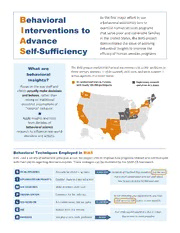
ERIC ED572862: Behavioral Interventions to Advance Self-Sufficiency PDF
Preview ERIC ED572862: Behavioral Interventions to Advance Self-Sufficiency
As the first major effort to use Behavioral a behavioral economics lens to examine human services programs I nterventions to that serve poor and vulnerable families in the United States, the BIAS project Advance demonstrated the value of applying behavioral insights to improve the Self-Sufficiency efficacy of human services programs. The BIAS project explored behavioral interventions to tackle problems in What are three primary domains — child support, child care, and work support — behavioral across agencies in a dozen states. insights? 15 randomized trials in 7 states, Exploratory research Focus on the way staff and with nearly 100,000 participants and pilots in 5 states clients actually make decisions and behave, rather than WA relying on traditional VT ME economic assumptions of NY “rational” behavior. OH IL IN Apply insights and tools CA MO KY from decades of OK behavioral science TX research to influence real-world decisions and actions. Behavioral Techniques Employed in BIAS BIAS used a variety of behavioral principles across the project sites to improve how programs interact and communicate with their clients regarding desired outcomes. These strategies can be illustrated by the SIMPLER framework. S OCIAL INFLUENCE Persuade by referencing peers IN NEW YORK Hundreds of Paycheck Plus members just like you had a short conversation with our staff about I MPLEMENTATION PROMPTS Establish steps to a desired action how to earn an extra $2,000 next year. M AKE DEADLINES Make deadlines prominent P ERSONALIZATION Customize for the individual By not attending your appointment, you may: LOSE up to $2,508 a year in cash benefits. L OSS AVERSION Emphasize losses, not just gains IN CALIFORNIA E ASE Reduce steps in a process Your child support payment is due in 3 days. R EMINDERS Use phone calls, texts, postcards IN OHIO Pay on time to avoid penalties. BIAS Snapshot of Findings In 11 of the 15 randomized controlled trials, behavioral “nudges” like reminders or simplified, personalized letters had a statistically significant impact on at least one primary outcome (shown below). Each test used a customized behavioral While effects were ... they are meaningful intervention for a desired outcome. usually modest... due to their scalability ... ... and low cost. INTERVENTION RESULTS (%) SAMPLE ADDED COST FOR BIAS Status SIZE INTERVENTION PROBLEM OF INTEREST STATEa Group – Quo = IMPACTb = 1,000 people Per person estimate CHILD SUPPORT INCREASE ORDER Texas 38.7 – 27.7 11.0*** $1.73 MODIFICATION REQUESTS BY INCARCERATED NONCUSTODIAL PARENTS Washington 41.3 – 9.4 31.9*** $10.46 INCREASE PAYMENT RATES Ohio 51.5 – 48.5 2.9*** $2.52 ON EXISTING CHILD SUPPORT ORDERS Ohio 40.7 – 38.2 2.4*** $3.25 Ohio 50.5 – 47.3 3.2** $3.25 CHILD CARE INCREASE TAKE-UP OF PROVIDERS Indiana 14.7 – 12.6 2.1* $1.40 RATED HIGH-QUALITY INCREASE ATTENDANCE Indiana 52.6 – 50.0 2.6* $1.93 AT FIRST SCHEDULED RENEWAL APPOINTMENT Indiana 54.7 – 44.1 10.6*** $2.79 INCREASE ON-TIME Oklahoma 36.7 – 34.4 2.4* $1.10 SUBSIDY RENEWALS WORK SUPPORT INCREASE MEETING ATTENDANCE New York 28.5 – 16.5 12.0*** $1.75 FOR TAX CREDIT PROGRAM INCREASE ENGAGEMENT IN California 29.2 – 25.6 3.6* $1.79 TEMPORARY ASSISTANCE FOR NEEDY FAMILIES aTests ran in one or more counties in each state. bStatistical significance levels: *** = 1 percent; ** = 5 percent; * = 10 percent. What’s Next? The BIAS project was funded by the federal Office of Planning, Research and Evaluation (OPRE) of the Administration for Children and Families in the U.S. Department of Health and Human Services, and led by MDRC. BIAS – Next Generation OPRE is continuing its partnership with MDRC to expand the use of behavioral science to a wider range of programs, go beyond “nudges,” include more implementation research, and develop tools for program administrators. Center for Applied Behavioral Sciences (CABS) This new initiative combines MDRC’s expertise in social and education programs with insights from behavioral science. CABS develops innovative, low-cost interventions, tests their impact through @ November 2016 experimentation, and provides technical assistance to programs incorporating behavioral insights. For more information, contact [email protected] Use #povertynudge to tweet about the project
